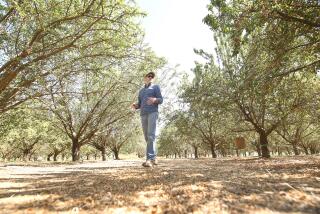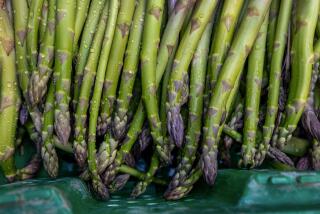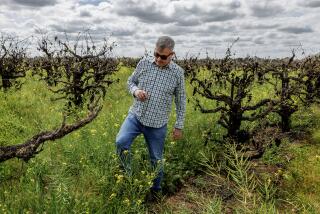State’s Almond Growers in Bind
YOLO, Calif. — Harry Dewey’s motorized shaker rolled up to an almond tree, stretched its hydraulic arms out to grasp the slim trunk in a stranglehold and shook the tree violently. The earth seemed to tremble for a few moments as almonds rained to the ground. Then the machine released its prey and maneuvered toward another of Dewey’s 200 acres of trees.
Dewey told a recent visitor that the 1985 harvest, which began Aug. 10, marks about his 50th, though his family has grown almonds in the Sacramento Valley since 1912. He and his wife, Jane, had figured on selling off their holdings here by now, he said, sweeping his arm in a gesture that took in the orchard.
“But who’d buy it?” he asked.
The Deweys’ grown children have left the farm, as have the children of their farming neighbors. Don Peart, who has one son in college and another in high school, doubts that either will join him in farming. “I’d love to have them,” Peart said, “but as things are now I don’t know that it’d be a wise choice.
‘Still Can’t Compete’
“We’re raising good crops-- super good crops--and we still can’t compete,” he said. “We’re not making any money, only operating on the equities that we built up over 30 years.”
Dewey said he last made a profit three or four years ago. He and his wife, who supervises the farm’s hulling operation, have had to nurse along rather than replace their aging equipment. This includes what she calls “a Rube Goldberg” series of conveyor belts, hull-crackers and nut sorters, along with a trio of trucks that Dewey’s son kindly refers to as “the vintage fleet.”
The two have reached their debt limit in producing the 1985 crop, Dewey said, “So you can’t do anything; you’re hammered in.”
The Deweys and the Pearts are fairly typical of California’s almond growers, 5,800 of whom (about 80% of all growers) own the California Almond Growers Exchange in Sacramento, which processes, packs and markets their crop under the Blue Diamond label. While consumption of almonds has increased significantly in the 1980s, supply has grown even more rapidly.
Part of Crop Remains in Storage
The 247,948 bearing acres of almond trees 10 years ago produced 186 million pounds of kernels, but this year 395,000 bearing acres are expected to produce 495 million pounds--second in size only to 1984’s record 587 million pounds. About a sixth of last year’s crop remains in storage, exerting a continuing downward pull on prices to growers, which peaked at $1.54 a pound in 1979 and slumped to 82 cents last year.
“We have a tremendous (marketing) challenge this year--after the tremendous challenge of last year,” said Roger Baccigaluppi, president and chief executive of the Sacramento-based California Almond Growers Exchange, the nation’s 42nd-largest agricultural cooperative and 99th-largest food company.
“There are going to be a fair number of failures, and the growers don’t deserve it, many of them,” he predicted. “The problem we have is the strong dollar, and that isn’t their fault.”
Pete Yamamoto, chairman of the California Almond Board, said, “It’s better to ship the almonds than store them, but we’re shipping them at prices lower than the farmers can produce them.”
Biggest Producer
California accounts for the entire U.S. commercial almond crop and 61% of the world’s supply (followed by Spain with 17%, Italy 8%, and lesser contributions from Portugal, Morocco, Iran, Israel, Chile, Australia, Greece, Cyprus, India and Afghanistan). Almonds are California’s largest food export, taking about two-thirds of last year’s crop.
That crop fetched less than $1 a pound, putting severe financial pressure on growers. Dewey, for example, estimates that his crop costs about 90 cents a pound to produce. Thus, last month’s huge sale of 20 million pounds of almonds to the Soviet Union--bringing the Soviet’s total for the year to more than 40 million pounds, displacing Japan as California’s second-largest almond customer (after West Germany), represents more of an investment than a return on investment, he said.
Steve Easter, the almond exchange’s vice president for member relations and government affairs, said wholesale almond prices have fallen by nearly half in five years from $1.90 a pound. “It should still be around $1.90,” he said.
The Soviet sale price ranged from $1.05 to $1.15 a pound wholesale, Baccigaluppi said. “There’s no question that it’s being sold at less than it costs to produce.” But the alternative--storing the crop--not only provides no payment at all to meet production costs but drags down future prices on both the world and domestic market, he added.
Better Days Ahead
“You’ve got growers out there who are desperate,” Baccigaluppi readily acknowledged. But, he predicted, those who can “stick it out” will find better days ahead.
Unlike many farm commodities, almond prices are not government supported, leaving the forces of supply and demand free to reward and wreak havoc, but generally clearing out stocks. That was not the case with last year’s unexpectedly large crop, however.
Consequently, the almond exchange closed its membership to growers last April, Easter said, “to send a strong signal” that there is more product than can be profitably sold. Last year’s record harvest not only more than doubled the poor 1983 crop of 240 million pounds (due to bad weather and poor pollination) and not only exceeded the exchange’s estimate for the year but its projection for 1990.
The only slightly less hefty 1985 crop would not be “really bothersome,” he said, if it weren’t for the 100-million-pound carry-over: “That’s the problem.” In addition, while the worldwide crop is expected to slip 2.2% to 750 million pounds, that would still be more than 9% larger than any previous world almond crop.
The almond growers aim to double consumption worldwide by 1990, Baccigaluppi said. Despite the currently high value of the dollar, export sales were up 127% in July and August, the first two months of the crop year, compared to 40% for domestic sales, he said. Besides the sixfold increase in Soviet sales in those months, exports to Japan rose 141%, West Germany 114%, Singapore-Malaysia 79%, United Kingdom 74% and France 68%. Moreover, domestic consumption for the two months increased 40% after only a 2% rise in 1984 (though consumption is up 45% over the last five years).
Aggressive Marketing
These increases didn’t just materialize, Baccigaluppi noted. “It took damned aggressive marketing!”
This rising consumption provides some basis for optimism, said Walter F. Payne, vice president for sales and marketing of the growers exchange. “Because of that we can see some light at the end of the tunnel.”
“What we’re doing,” added Baccigaluppi, “is . . . showing everything that can be done with almonds.” He cited the case of almond butter--a spread analogous to peanut butter--whose consumption has increased from 60,000 pounds just four years ago to 30 million pounds last year.
The Japanese, who placed their first Blue Diamond order only in 1969, are now among the most innovative almond consumers, he said. They use almonds in cosmetics, combine it with cheese and sausage, and add it to milk and even traditional tofu . (“Now that was a breakthrough,” he said.) Today, the Japanese consume a quarter-pound of almonds per person a year, compared to six-tenths of a pound in the United States.
The exchange today maintains a staff of 50 in Japan, headed by senior managing director Masuo Koga.
Almond growers obviously welcomed last week’s agreement by central bank officials representing the United States, Japan, the United Kingdom, France and West Germany to intervene in world money markets to reduce the value of the dollar. But they still worry that any relief will prove transitory until the federal budget deficit can be brought under control.
Dollar Is Problem
The strong dollar is causing the greatest woe. Yamamoto of the California Almond Board, who supplements his nut crop with a few acres of zinfandel grapes that he ships to Canada, said his Canadian buyer complained, “Pete, I send you a dollar and you send me 63 cents of grapes.”
While trade restrictions are nettlesome, the risk of retaliation is greater, Baccigaluppi warned. “All we need to do is make a couple of wrong moves, then our trading partners make a wrong move. . . . “
Because of the almond growers’ dependency on the vagaries of the export market, the exchange intends to redouble efforts to increase consumption at home. “You’re going to see a lot of almonds in (market) produce sections selling for $1.59 to $1.79 a pound,” Payne predicted. There will also be more gift packages sold in supermarkets, new cellophane-wrapped “four-packs” for promotional sales in such non-food outlets as drugstores, “five or six” new candy bars and a shelf of new cereals and snacks containing almonds.
“With the low prices we’ve had with almonds,” Payne said, looking on the bright side, “things are beginning to hit.”
CALIFORNIA ALMOND PRODUCTION
Bearing Acres Yield per acre Production Farm Price (lbs per acre) (thousand lbs, (per lb) shelled) 1975 247,948 755 186,000 $0.68 1976 257,854 1,110 284,000 0.65 1977 273,417 1,123 313,000 0.84 1978 303,592 596 181,000 1.45 1979 321,370 1,166 376,000 1.54 1980 324,878 991 322,000 1.47 1981 326,206 1,249 407,000 0.78 1982 334,258 1,038 347,000 0.94 1983 356,223 679 242,000 1.04 1984 379,565 1,546 587,000 0.82 1985* 395,000 ---- 495,000 ----
DELIVERED SALES (1000 lbs / shelled)
Domestic Export 1980 95,477 186,934 1981 115,882 207,894 1982 128,281 177,980 1983 128,588 171,699 1984 131,359 266,762
California Crop and Livestock Reporting Service, Almond Board of California.
More to Read
Sign up for Essential California
The most important California stories and recommendations in your inbox every morning.
You may occasionally receive promotional content from the Los Angeles Times.









